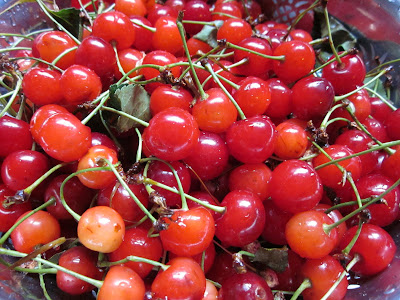
Split Pea Soup
Pea soup is ubiquitous in Northern Europe. It's simple, hearty, inexpensive and can feed an entire family for days from the same pot, but it's also got some interesting history. Remember the old 'Peas porridge hot, peas porridge cold, peas porridge in the pot, 9 days old' rhyme? It likely dates back to the middle ages, when it was common to put a pot of thick pea-based stew on the fire and as the stew was consumed and the pot neared empty, more ingredients were thrown in to top it off. A pot of stew left like this could be continuously on the fire for days or weeks at a time.
There's been a movement to 'modernize' pea soup from sources like Saveur and Cook's Illustrated, recommending less cook time and a more complex preparation. The results tend to have a texture more like a pot of beans, with every pea separated and an unfamilar flavor. These are great on their own, but I wouldn't consider them pea soup. The Greeks have a traditional version of this soup which is nearly identical to the Scandinavian versions, and even some African countries do.
The bottom line? Everyone loves pea soup! This is a go-to comfort food for millions of people that is definitely best the old fashioned way: thick, creamy and full of smokey bits of ham.
Split peas are related to lentils and come in a variety of colors and sizes. The most common in the US is the green split pea, but dried whole green peas, yellow peas, or any color of lentil can be substituted. Whole Golden Peas are traditional in Scandinavia and it makes a beautiful, cheery yellow stew. You can also mix and match - half and half yellow and green peas will keep your pea soup bright green with no chance of it looking murky or grey. If substituting lentils for the peas in this recipe, make sure to wait and add the lentils only in the last 2 hours of cooking, since they cook much much faster than peas do and will break down quickly.

Ingredients
1 Large Crock Pot or slow cooker
2 C Split Peas
2 Sweet or Yellow Onions
4 Bay Leaves
1 Smoked Ham Shank
5 C Water
Salt and Pepper
1/4 C Red Wine Vinegar
A note about ham: Your choice of ham will make or break this soup. Choose high quality ham with lots of smokey meat on it - shanks are better than hocks, which are mostly gristle. Alternatively, just use a small boneless ham but try to find one that's all natural or cured without nitrites if you can. This will make your soup both tastier and healthier. (Yes, those are hocks in the photos. Do as I say and not as I do!)
Rinse the peas in a colander and pick out any stones, stems or bad peas.
Peel and dice the onions. Big chunks are ok but small diced onion will cook faster. You can even shred them on a cheese grater.

If using dried peas, reserve 1/2 cup of peas and throw the peas, onions, ham, bay and water into the crock pot. If using lentils or soaked peas, reserve all the peas and add them in to the rest of the ingredients after 2 hours.

Cooking times vary a lot. The best advice I can give is to make this first on a day when you're home and can check it often. Length of cooking will vary depending on how fresh your peas are, what kind you're using, and the size and type of ham in the pot. To speed it up, soak your peas (don't soak lentils) overnight in a bowl covered with water. I don't recommend this method - the ham never gets enough time to cook and the soup tastes a little watered down.
8-10 Hours: Unsoaked Whole Dried Peas
6-8 Hours: Unsoaked Split Peas
2-4 Hours: Dried Lentils, Soaked Peas
Set the crock pot on High for 30 minutes to bring everything up to temperature, then turn it down to Low or Warm. It's good to check the soup every half hour or hour and stir it, though it's not strictly necessary. Cover the pot with a towel to insulate it.

Ham Hocks, steamy and tender after 4 hours
After 4 hours, check to see if the ham is cooked: it'll be tender and falling apart to the touch. Once the ham is cooked, pull it out and let it cool for about 30 minutes so you don't burn your fingers, then shred all the good meat back into the soup and add the reserved peas. This will add some texture to a soup that would otherwise be just a thick slurry. Throw out the ham bones, gristle and skin.

The Final Product
Continue to cook until you like the texture. It should be creamy and thick without any crunch. If the soup gets too thick, add a little water to thin it.
Add the Red Wine Vinegar, then salt and pepper to taste. Serve with crackers.
Delish!


















































